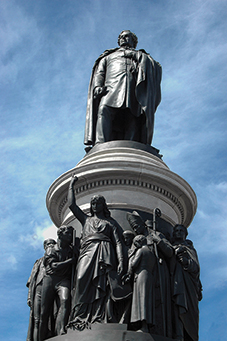5 Ireland and national identity
If the period to 1840 was a time when nationalists elsewhere in Europe sought to overthrow existing governmental structures, it might be argued that national sentiment in England, Scotland and Wales had been successfully channelled into ‘British’ calls for peaceful constitutional reform. A similar process occurred in Ireland, although the circumstances were very different. For a range of reasons (including the admittance of Irish Catholics to the franchise in 1793, and the abolition of rotten boroughs after the Union), the cause of electoral reform did not have the same sense of urgency and did not command the support of the masses in Ireland in the same way that it did in Britain. Instead, however, the movement in favour of Catholic emancipation became the central focus of both popular politics, and national sentiment, in an Irish context.
After 1800, many Irish Protestants, including members of loyalist or conservative associations, who had been vocal in their opposition to the Union, quickly reconciled themselves to the idea, and even began to embrace a new ‘British’ identity. That said, some Protestants never embraced the Union. Robert Emmet (1778–1803), for example, supported by the remnants of the United Irishmen, staged a short-lived rebellion in 1803. Meanwhile some Irish MPs, such as Henry Grattan, whom you encountered in Section 1, continued to call for repeal of the Union and supported Catholic calls for further relief legislation in Westminster after 1801. As for Ireland’s Roman Catholic community, at the time of the Union the British government had successfully courted their support for the measure by leading them to believe that Catholic emancipation would be introduced in its immediate aftermath. However, a range of internal and external pressures on the British government, including intense opposition from the king and cabinet ministers, had meant that that emancipation had not been introduced at the time (Geoghegan, 2001). This development can be seen to have seriously undermined the extent to which a ‘British’ national identity could ever take root among the majority of people living in early nineteenth-century Ireland.
From the 1810s, the movement in favour of Catholic emancipation in Ireland gathered pace, under the leadership of a Roman Catholic barrister, Daniel O’Connell (1775–1847, depicted in Figure 9). In 1823, O’Connell and Richard Lalor Sheil (1791–1851) founded the Catholic Association, an organisation that was remarkably successful in gaining support across the social spectrum in Ireland, from landed Catholics and the middle classes, to the illiterate, Irish speakers and the poor. By 1829, the association had well over 3 million members. The organisation coordinated the movement in favour of Catholic emancipation in Ireland by organising a range of peaceful political activities, including petitioning campaigns, open-air ‘monster’ meetings and appeals to the public and politicians through the press, even arranging a ‘Catholic census’ in 1825 to highlight the numerical disparity between Protestants and Catholics in the country. In the general election of 1826, O’Connell was elected MP for County Clare by a huge majority but, as a Roman Catholic, he was not permitted to take his seat in Parliament. Public agitation in favour of emancipation intensified in Ireland hereafter, and concern grew in Britain that the country might descend into rebellion.

However, the movement for Catholic emancipation in Ireland was not revolutionary, republican or radical in its aims. Indeed, it can be seen as a movement for the greater representation of Roman Catholics within the United Kingdom. O’Connell was an advocate of non-violent political reform along British liberal lines and although he had been an opponent of the legislative Union between Ireland and Britain, he did not want the two countries to sever ties completely, but instead remain united through the institution of monarchy. It is notable, however, that O’Connell’s supporters did not necessarily share these views. Indeed, an emerging sense of Irish national identity, specifically an Irish Catholic national identity, was evident among many Irish proponents of the campaign for Catholic emancipation (Hoppen, 1999).
In the years that followed the passage of the Catholic Relief Act of 1829, O’Connell and his Repeal Association, founded in 1830, went on to lead a mass political movement calling for the repeal of the Union and the restoration of the Irish Parliament, pursuing many of the same peaceful tactics as the Catholic Association. In 1842, three members of the Repeal Association, Charles Gavan Duffy (1816–1903), Thomas Davis (1814–1845) and John Blake Dillon (1814–1866), established a weekly newspaper entitled The Nation in the hope of directing ‘the popular mind and the sympathies of educated men of all parties to the great end of nationality … a nationality which may embrace Protestant, Catholic, and Dissenter’ (quoted in Sillard, 1908, pp. 3–4). The newspaper soon attained a readership of over 10,000 people and helped to create support for O’Connell’s repeal movement (Bartlett, 2010).
From 1830 to 1836, another campaign of civil disobedience emerged in Ireland, in this case agitating for the removal of tithes, a payment made for the upkeep of the Protestant Church of Ireland. Although this campaign was one punctuated with violent episodes, it was not until the late 1840s that a more radical, violent, revolutionary strand of Irish nationalism came to the fore once again when the ‘Young Irelanders’ – a group very closely associated with The Nation newspaper – split from the Repeal Association. Although radical Irish nationalism did not pose a serious threat to the political cohesion of the United Kingdom until later in the nineteenth century, the development of both national identity and popular politics in Ireland was already very different from that unfolding in the rest of Britain.
